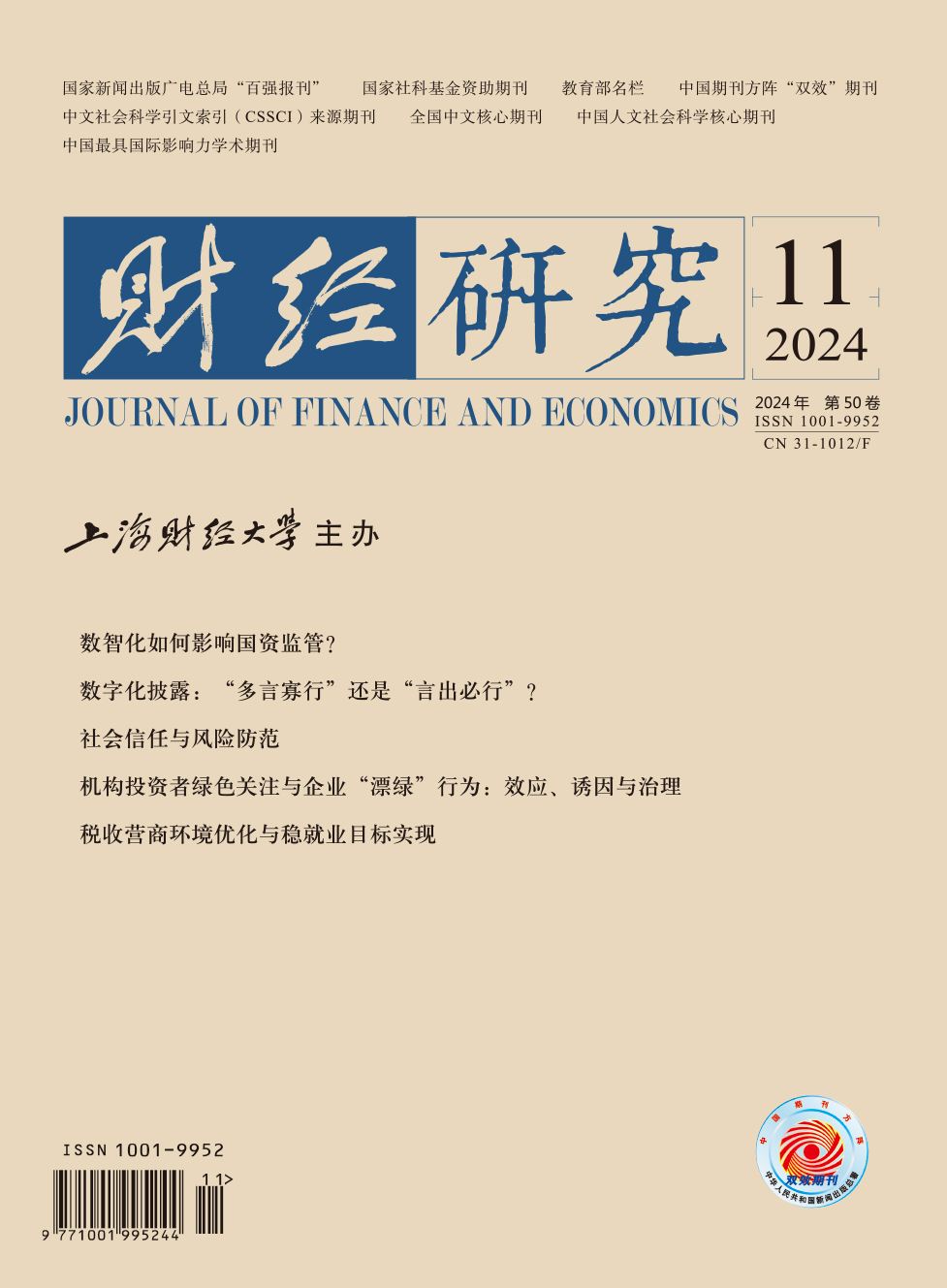异质性雇用成本、社会福利与劳动力市场结构性改革
财经研究 2015 年 第 41 卷第 01 期, 页码:49 - 61
摘要
参考文献
摘要
通过扩展Blanchard和Galí(2010)的雇用成本模型,文章构建了一个包含正规部门与非正规部门的异质性雇用成本的NKMP-DSGE模型。外生冲击的贝叶斯脉冲响应函数表明,正规部门就业与非正规部门就业对于同一外生冲击具有不同的反应,这意味着考虑不同部门的异质性是合理的。社会福利分析的结果指出,非正规部门的存在尽管通过降低名义价格刚性而改善了社会福利,但通过失业回滞却导致了社会福利的恶化;而且总体而言恶化了社会福利。这一发现为我国当前正在积极推行的劳动力市场结构性改革提供了理论依据。在此基础上,文章进一步考察了劳动力市场结构性改革的效应。研究发现,不管是长期效应还是短期效应,改革都有利于改善劳动力市场的表现。
[1]蔡昉.中国劳动力市场发育与就业变化[J].经济研究,2007,(7):4-14.
[2]常进雄,王丹枫.我国城镇正规就业与非正规就业的工资差异[J].数量经济与技术经济研究,2010,(9):94-106.
[3]陈利锋.货币政策应该对劳动力市场做出反应吗?[J].浙江社会科学,2014a,(2):15-24.
[4]陈利锋.二元市场、信贷摩擦与货币政策——货币政策应对劳动力市场做出反应吗?[J].云南财经大学学报,2014b,(2):83-95.
[5]陈利锋,范红忠.房价波动、货币政策与中国社会福利损失[J].中国管理科学,2014,(5):42-50.
[6]崔百胜.非正规金融与正规金融:互补还是替代?——基于DSGE模型的相互作用机制的研究[J].财经研究,2012,(7):121-132.
[7]丁守海,蒋家亮.中国存在失业回滞现象吗?[J].管理世界,2013,(1):56-66.
[8]李成,王彬,马文涛.资产价格、汇率波动与最优利率规则[J].经济研究,2010,(3):91-103.
[9]罗楚亮.就业稳定性与工资收入差距研究[J].中国人口科学,2008,(4):11-21.
[10]吕朝凤,黄梅波.习惯形成、借贷约束与中国经济周期特征——基于RBC模型的实证研究[J].金融研究,2011,(9):1-13.
[11]屈小博.城市正规就业与非正规就业收入差距及影响因素贡献——基于收入不平等的分解[J].财经论丛,2011,(2):3-8.
[12]任远,彭希哲.中国非正规就业发展报告(2006)[M].重庆:重庆出版社,2007.
[13]王君斌,王文甫.非完全竞争市场、技术冲击和中国劳动就业——动态新凯恩斯主义的视角[J].管理世界,2010,(1):23-35.
[14]魏下海,余玲铮.我国城镇正规就业与非正规就业工资差异的实证研究——基于分位数回归与分解的发现[J].数量经济技术经济研究,2012,(1):78-90.
[15]徐蔼婷.非正规部门生产规模的估算:数据比较法——以浙江省为例[J].浙江社会科学,2008,(6):33-39.
[16]徐蔼婷,刘波,李金昌.居民收入分配如何影响非正规经济规模——基于城镇中等收入阶层收入份额的考察[J].经济学家,2012,(4):29-36.
[17]Angelopoulos K,Jiang W,Malley J.Tax reforms under market distortions in product and labour markets[J].European Economic Review,2013,61(C):28-42.
[18]Aruoba S B.Informal sector,government policy and institutions[R].Society for Economic DynamicsMeeting Papers,No.324,2010.
[19]Levine P,Lotti E,Batini N,et al.Informal labour and credit markets:A survey[R].IMF Working Paper,No.WP/10/42,2010.
[20]Blanchard O,GalíJ.Labor markets and monetary policy:A new Keynesian model with unemployment[J].American Economic Journal:Macroeconomics,2010,2(2):1-30.
[21]Calvo G A.Staggered prices in a utility-maximizing framework[J].Journal of Monetary Economics,1983,12(3):983-998.
[22]Cai H,Wang M,Yan S.Why do large firms willingly pay high wages in developing countries?[R].Peking University,Guanghua School of Management Working Paper,2013.
[23]Chen M.The informal economy:Definitions,theories,data and policies[R].WIEGO Working Paper,2012.
[24]Choudhary M,Naeem S,Faheem A,et al.Formal sector price discoveries:Result from a developing country[R].University of Surrey,School of Economics Discussing Papers No.1011,2011.
[25]Coenen G,McAdam P,Straub R.Tax reform and labour-market performance in the Euro area:A simulation-based analysis using the New Area-Wide Model[J].Journal of Economic Dynamics and Control,2008,32(8):2543-2583.
[26]GalíJ.Notes for a new guide to Keynes(I):Wages,aggregate demand,and employment[J].Journal of the European Economic Association,2013,11(5):973-1003.
[27]GalíJ,Lpez-Salido J D,Valles J.Understanding the effects of government spending on consumption[J].Journal of the European Economics Association,2007,5(1):227-270.
[28]Gertler M,Trigari A.Unemployment fluctuations with staggered nash wage bargaining[J].Journal of Political Economy,2009,117(1):38-86.
[29]Giannoni M,Woodford M.Optimal inflation-targeting rules[A].Bernanke B S.,Woodford M.The Inflation Targeting Debate[C].Chicago:University of Chicago Press,2005.
[30]He D,Zhang W,Shek J.How efficient has been China’s investment?Empirical evidence from national and provincial data[J].Pacific Economic Review,2007,12(5):597-617.
[31]La Porta R,Shleifer A.Informality and development[J].Journal of Economic Perspective 2014,28(3):109-126.
[32]Oris R,Raggi D,Turino F.Size,trend,and policy implications of the underground economy[J].Review of Economic Dynamics,2014,17(3):417-436.
[33]Perry G,Maloney W,Arias O,et al.Informality:Exit and exclusion[R].World Bank Report,2007.
[34]Ravenna F,Walsh C E.Welfare-based optimal monetary policy with unemployment and sticky prices:A linear-quadratic framework[J].American Economic Journal:Macroeconomics,2011,3(2):130-162.
1发达国家也存在非正规部门,但更多指的是地下经济(Auroba,2010;Oris等,2014)。发展中国家非正规部门则包括自我雇用、家族企业和微型企业等。对于我国而言,已有研究均认为非正规就业包括城镇私营企业从业人员、个体经济从业人员以及大量从事非正规就业的且未纳入就业统计范畴的从业人员。
2Perry等(2007)调查的国家包括玻利维亚、印度、尼日利亚、巴拿马、巴基斯坦、巴拉圭以及秘鲁。
1 正规部门的工作稳定性高于非正规部门,罗楚亮(2008)发现工作不稳定群体的收入仅为具有稳定工作群体收入的
65 %;魏下海和余玲铮(2012)估算的结果发现正规部门工资水平比非正规部门高35.4%。
1崔百胜(2012)构建了一个包含正规金融与非正规金融的模型,但其主要讨论的是金融市场。
1劳动力市场紧度是搜寻与匹配模型中一个重要的变量,一般而言,岗位空缺的数量越多,劳动力市场紧度取值越大,而这一变量也度量了失业者找到工作的概率。
1另外,参数η的贝叶斯估计值为5.7901;政策规则参数rp和ry的贝叶斯估计值分别为0.6049和0.9692,对应的货币政策冲击持续性参数及其标准差的估计值分别为0.7722和0.2014。
1当然,理论模型与实际情况不可能完全一致。这里我们仅仅是做一个简单的政策模拟处理,即使B1与BF相等,两部门的雇用成本仍会受劳动力市场紧度的影响而存在差异。这里仅仅设定二者在形式上趋于一致。
[2]常进雄,王丹枫.我国城镇正规就业与非正规就业的工资差异[J].数量经济与技术经济研究,2010,(9):94-106.
[3]陈利锋.货币政策应该对劳动力市场做出反应吗?[J].浙江社会科学,2014a,(2):15-24.
[4]陈利锋.二元市场、信贷摩擦与货币政策——货币政策应对劳动力市场做出反应吗?[J].云南财经大学学报,2014b,(2):83-95.
[5]陈利锋,范红忠.房价波动、货币政策与中国社会福利损失[J].中国管理科学,2014,(5):42-50.
[6]崔百胜.非正规金融与正规金融:互补还是替代?——基于DSGE模型的相互作用机制的研究[J].财经研究,2012,(7):121-132.
[7]丁守海,蒋家亮.中国存在失业回滞现象吗?[J].管理世界,2013,(1):56-66.
[8]李成,王彬,马文涛.资产价格、汇率波动与最优利率规则[J].经济研究,2010,(3):91-103.
[9]罗楚亮.就业稳定性与工资收入差距研究[J].中国人口科学,2008,(4):11-21.
[10]吕朝凤,黄梅波.习惯形成、借贷约束与中国经济周期特征——基于RBC模型的实证研究[J].金融研究,2011,(9):1-13.
[11]屈小博.城市正规就业与非正规就业收入差距及影响因素贡献——基于收入不平等的分解[J].财经论丛,2011,(2):3-8.
[12]任远,彭希哲.中国非正规就业发展报告(2006)[M].重庆:重庆出版社,2007.
[13]王君斌,王文甫.非完全竞争市场、技术冲击和中国劳动就业——动态新凯恩斯主义的视角[J].管理世界,2010,(1):23-35.
[14]魏下海,余玲铮.我国城镇正规就业与非正规就业工资差异的实证研究——基于分位数回归与分解的发现[J].数量经济技术经济研究,2012,(1):78-90.
[15]徐蔼婷.非正规部门生产规模的估算:数据比较法——以浙江省为例[J].浙江社会科学,2008,(6):33-39.
[16]徐蔼婷,刘波,李金昌.居民收入分配如何影响非正规经济规模——基于城镇中等收入阶层收入份额的考察[J].经济学家,2012,(4):29-36.
[17]Angelopoulos K,Jiang W,Malley J.Tax reforms under market distortions in product and labour markets[J].European Economic Review,2013,61(C):28-42.
[18]Aruoba S B.Informal sector,government policy and institutions[R].Society for Economic DynamicsMeeting Papers,No.324,2010.
[19]Levine P,Lotti E,Batini N,et al.Informal labour and credit markets:A survey[R].IMF Working Paper,No.WP/10/42,2010.
[20]Blanchard O,GalíJ.Labor markets and monetary policy:A new Keynesian model with unemployment[J].American Economic Journal:Macroeconomics,2010,2(2):1-30.
[21]Calvo G A.Staggered prices in a utility-maximizing framework[J].Journal of Monetary Economics,1983,12(3):983-998.
[22]Cai H,Wang M,Yan S.Why do large firms willingly pay high wages in developing countries?[R].Peking University,Guanghua School of Management Working Paper,2013.
[23]Chen M.The informal economy:Definitions,theories,data and policies[R].WIEGO Working Paper,2012.
[24]Choudhary M,Naeem S,Faheem A,et al.Formal sector price discoveries:Result from a developing country[R].University of Surrey,School of Economics Discussing Papers No.1011,2011.
[25]Coenen G,McAdam P,Straub R.Tax reform and labour-market performance in the Euro area:A simulation-based analysis using the New Area-Wide Model[J].Journal of Economic Dynamics and Control,2008,32(8):2543-2583.
[26]GalíJ.Notes for a new guide to Keynes(I):Wages,aggregate demand,and employment[J].Journal of the European Economic Association,2013,11(5):973-1003.
[27]GalíJ,Lpez-Salido J D,Valles J.Understanding the effects of government spending on consumption[J].Journal of the European Economics Association,2007,5(1):227-270.
[28]Gertler M,Trigari A.Unemployment fluctuations with staggered nash wage bargaining[J].Journal of Political Economy,2009,117(1):38-86.
[29]Giannoni M,Woodford M.Optimal inflation-targeting rules[A].Bernanke B S.,Woodford M.The Inflation Targeting Debate[C].Chicago:University of Chicago Press,2005.
[30]He D,Zhang W,Shek J.How efficient has been China’s investment?Empirical evidence from national and provincial data[J].Pacific Economic Review,2007,12(5):597-617.
[31]La Porta R,Shleifer A.Informality and development[J].Journal of Economic Perspective 2014,28(3):109-126.
[32]Oris R,Raggi D,Turino F.Size,trend,and policy implications of the underground economy[J].Review of Economic Dynamics,2014,17(3):417-436.
[33]Perry G,Maloney W,Arias O,et al.Informality:Exit and exclusion[R].World Bank Report,2007.
[34]Ravenna F,Walsh C E.Welfare-based optimal monetary policy with unemployment and sticky prices:A linear-quadratic framework[J].American Economic Journal:Macroeconomics,2011,3(2):130-162.
1发达国家也存在非正规部门,但更多指的是地下经济(Auroba,2010;Oris等,2014)。发展中国家非正规部门则包括自我雇用、家族企业和微型企业等。对于我国而言,已有研究均认为非正规就业包括城镇私营企业从业人员、个体经济从业人员以及大量从事非正规就业的且未纳入就业统计范畴的从业人员。
2Perry等(2007)调查的国家包括玻利维亚、印度、尼日利亚、巴拿马、巴基斯坦、巴拉圭以及秘鲁。
1 正规部门的工作稳定性高于非正规部门,罗楚亮(2008)发现工作不稳定群体的收入仅为具有稳定工作群体收入的
65 %;魏下海和余玲铮(2012)估算的结果发现正规部门工资水平比非正规部门高35.4%。
1崔百胜(2012)构建了一个包含正规金融与非正规金融的模型,但其主要讨论的是金融市场。
1劳动力市场紧度是搜寻与匹配模型中一个重要的变量,一般而言,岗位空缺的数量越多,劳动力市场紧度取值越大,而这一变量也度量了失业者找到工作的概率。
1另外,参数η的贝叶斯估计值为5.7901;政策规则参数rp和ry的贝叶斯估计值分别为0.6049和0.9692,对应的货币政策冲击持续性参数及其标准差的估计值分别为0.7722和0.2014。
1当然,理论模型与实际情况不可能完全一致。这里我们仅仅是做一个简单的政策模拟处理,即使B1与BF相等,两部门的雇用成本仍会受劳动力市场紧度的影响而存在差异。这里仅仅设定二者在形式上趋于一致。
引用本文
陈利锋. 异质性雇用成本、社会福利与劳动力市场结构性改革[J]. 财经研究, 2015, 41(1): 49–61.
导出参考文献,格式为:





 6429
6429  3012
3012

